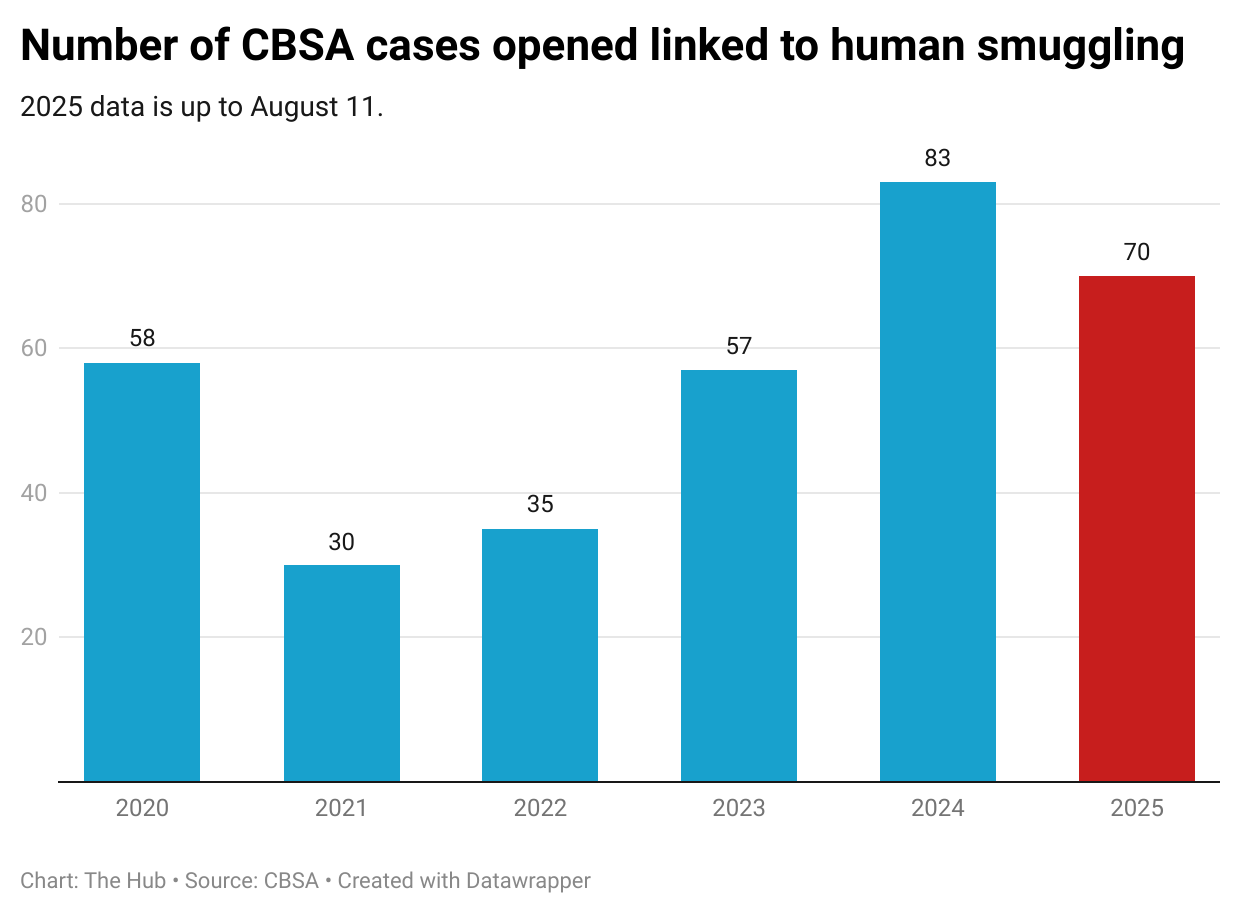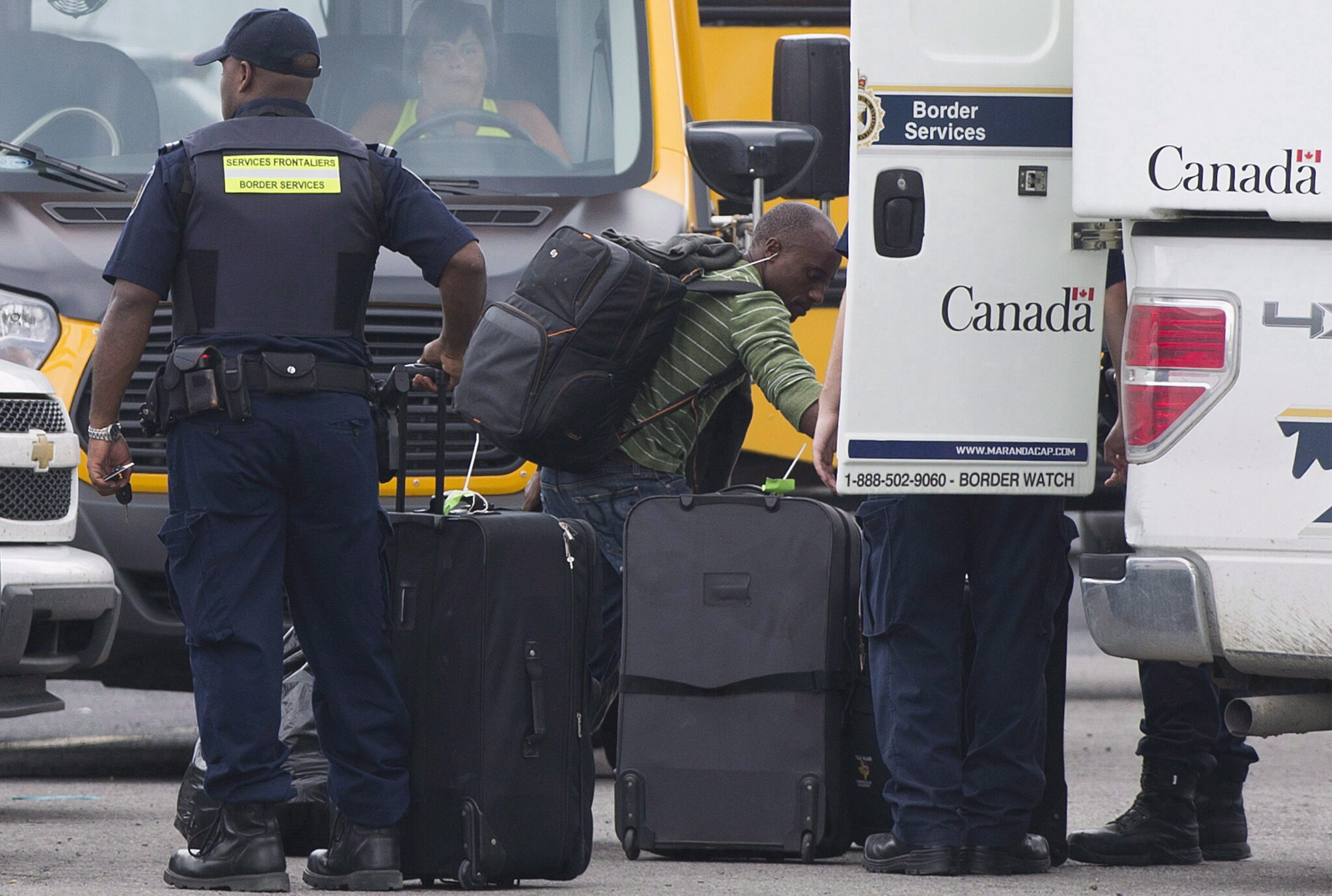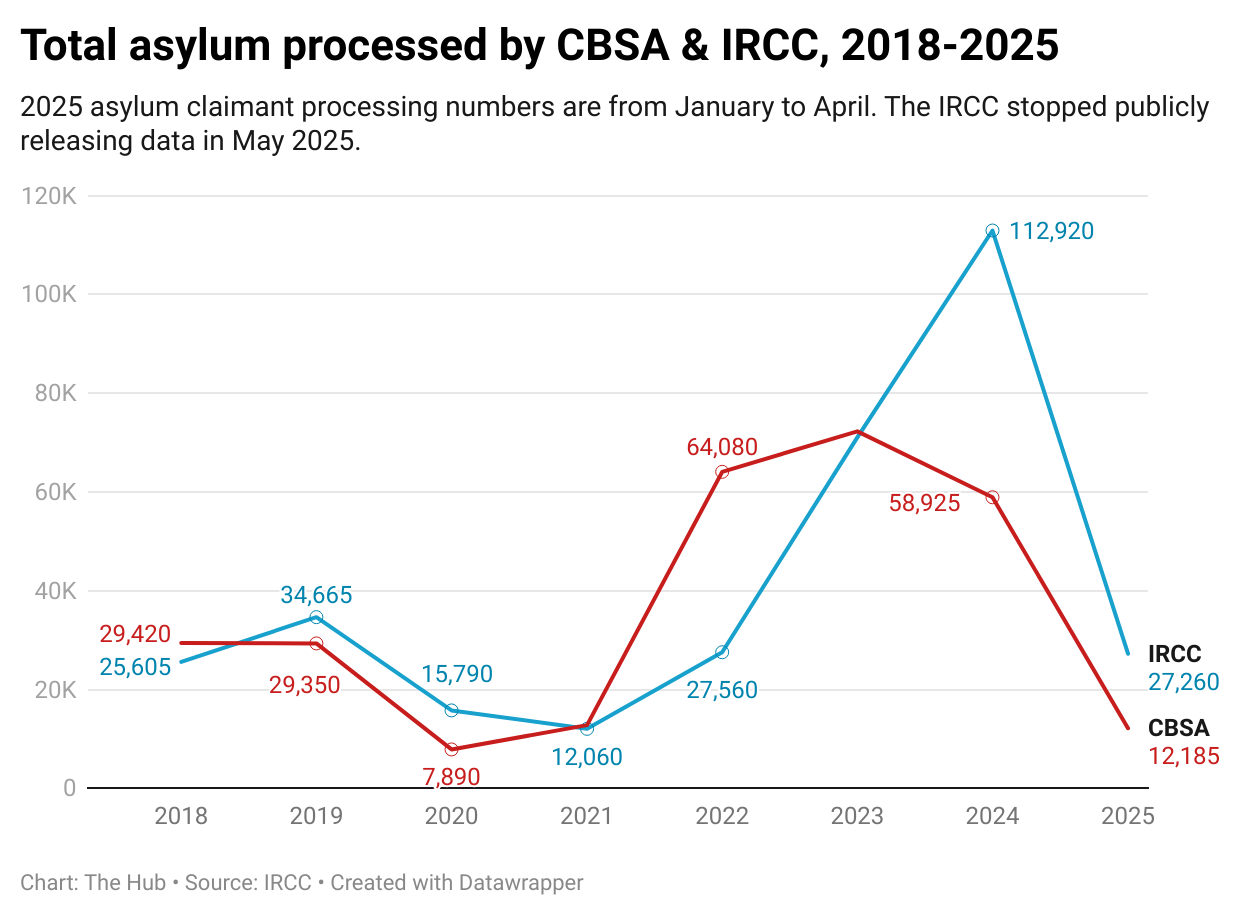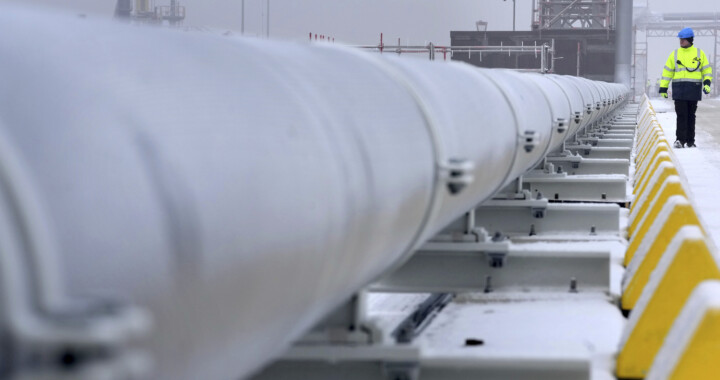As of last week the Canada Border Services Agency (CBSA) has opened 70 cases involving human smugglers in 2025, on track to be a record spike in the average rate of human smuggling cases over the previous five years. The 70 cases over seven months equates to an average of nearly 10 cases per month. When compared to 2024, that’s more than 40 percent increase in average monthly cases.
According to CBSA data provided exclusively to The Hub, for all of 2024, CBSA filed 83 cases involving human smuggling, at an average rate of 6.9 cases per month. This represented a marked rise from the 57 cases filed in 2023.

In one of the more recent human smuggling cases, the Royal Canadian Mounted Police (RCMP) and the CBSA arrested four individuals allegedly involved in smuggling 44 asylum claimants across the U.S.-Canada border into Quebec. Border enforcement officers found the nearly four dozen people, including children as young as four and a pregnant woman, in “horrific” conditions, lacking air, dehydrated, and crammed in the back of a cube truck.
The human-smuggler suspects were charged with assisting individuals to enter Canada outside of a designated customs office and inducing, aiding, or abetting someone to commit an offence under the Immigration and Refugee Protection Act.
Last week, the CBSA and RCMP also released a joint statement revealing they had arrested another two suspects in Quebec’s Valleyfield region attempting to smuggle 11 foreign nationals. The press release also disclosed that the CBSA is “currently investigating other individuals suspected of being linked to numerous other illegal crossings in Quebec…”
There are conflicting views in Canada on the Safe Third Country Agreement (STCA), a bilateral agreement between Canada and the U.S. enacted in 2004 that generally requires refugee claimants to register at the first “safe” country they arrive in. The agreement didn’t apply to unofficial ports of entry, which led to an influx, starting in 2018, of refugees illegally crossing the border into Canada claiming asylum. The STCA was amended in 2023, which resulted in expanding the STCA to extend across the entirety of the border. However, a loophole was left in place where any asylum seeker who avoids apprehension at the border and waits 15 days once in Canada can file a refugee claim without being returned to the U.S.
“I would say [the current (SCTA) is] incentivizing people to fall into the hands of human smugglers who take people across dangerous routes. We know people have not only lost their limbs to frostbite, but they’ve actually died crossing this way,” Toronto-based refugee lawyer Maureen Silcoff said to The Hub in a phone interview.
The Conservative Party of Canada’s position is that the current version of the STCA doesn’t go far enough.
“Part of the reason why that’s happening is that the Safe Third Country Agreement still contains loopholes that are being exploited by illegal border crossers. So it really is incumbent on the Liberal government to say why those exist and why they’re not doing more to strengthen the [STCA],” Conservative MP and Shadow Minister of Immigration Michelle Rempel Garner said in a phone interview.

A man removes his belongings from a CBSA truck at a processing centre for asylum seekers at the Canada-United States border in Lacolle, Que. Thursday, August 10, 2017. Graham Hughes/The Canadian Press.
Whether connected directly or indirectly to the increased cases of human smuggling in the last two-and-a-half years, then U.S. president Joe Biden struck a deal to amend the STCA with Prime Minister Justin Trudeau’s Liberal government back in March 2023.
The amendment allowed Canada to send back irregular asylum seekers who illegally cross into Canada at unofficial ports of entry on the largest undefended border in the world. In return, the Canadian government agreed to welcome 15,000 migrants from the U.S. asylum system.
The Standing Committee on Citizenship and Immigration previously issued a report on the amendments to the STCA that found it would put the vulnerable at elevated risk of human smuggling.
“…The government itself noted that [the changes to the STCA] could put more women and children at risk because it would push them into the hands of human smugglers in order to try to cross undetected,” said Silcoff. “It came as a shock to everyone, including people who work in the refugee field, because there was no prior consultation, discussion or any warning that the STCA would be extended [across the entire border].”
Before changes to the STCA in 2023, asylum seekers were able to cross the border at unofficial ports of entry—like at Roxham Road— and be processed by authorities without being sent back to the States. Now, asylum seekers have to evade being apprehended by authorities when illegally crossing the border and wait out the 14-day clock.
Many attempt this feat on their own, but other asylum seekers choose smugglers to get them across.
Today’s STCA rules generally stipulate that asylum seekers entering Canada by the land border be sent back to the U.S. to make their claims there, unless individuals’ cases fall under exemptions, like having a family member already living in Canada.
The overall scope of human smuggling of asylum seeker cases is unknown, but could be bigger than we think
In addition to the CBSA smuggling cases, the RCMP also apprehends human smugglers. But the RCMP numbers have not been released.
“The RCMP processes its own human smuggling cases at the border separately from the cases in which the CBSA apprehends the suspects,” RCMP media relations officer Camille Boily-Lavoie told The Hub. “Unfortunately, we are unable to provide this data [on human smuggling cases].”
The overall numbers of asylum claimants successfully evading authorities—with or without the aid of smugglers—remains a mystery to the public.
CBSA informed The Hub that the agency processed 44 percent fewer asylum claimants in the first seven months of 2025 compared to 2024 for the same time period. However, refugee claimants smuggled or who are themselves illegally crossing the border would be more likely to apply for refugee status with Immigration, Refugee, and Citizenship Canada (IRCC). Those seeking asylum in Canada, and already within the country’s borders, can register an asylum claim through IRCC’s online portal.
Since July 2023, the IRCC has consistently surpassed the monthly asylum claimants processed when compared to CBSA. But IRCC stopped releasing its monthly reports on asylum claimant figures in May.

“While monthly data is still available upon request, we are in the process of updating how we share immigration data with Canadians and improving how information is presented online. The goal is to provide clearer explanations of trends and greater context to help Canadians better understand data about key IRCC programs,” IRCC communications advisor Jeffrey MacDonald told The Hub.
IRCC previously did not respond to repeated requests about the missing data for this story, starting back in July. The lack of data has fueled criticism.
“As part of this work, we’re updating our web content to make the data more accessible and meaningful. The most recent statistics will be published shortly. This initiative reflects our ongoing commitment to transparency, accountability, and client service.”
Minister of Immigration, Refugees and Citizenship Lena Diab did not directly respond to questions for this story sent to her office, instead The Hub was referred to an IRCC spokesperson, the Department of Public Safety, CBSA, and the RCMP.
How the Government of Canada is responding to asylum seekers in 2025
A total of 955 people illegally crossing between Canada’s official ports of entry were removed to the U.S. from the start of 2025 until the middle of August. In comparison, a total of 984 people who crossed at unofficial ports of entry from the U.S. to Canada were turned back for all of 2024.
The CBSA removed over 18,000 inadmissible people in 2024, the most in a decade, or 30.5 percent of all asylum claimants processed by the CBSA last year. At official ports of entry, 2,462 asylum claims were rejected in 2024 compared to an already 2,006 claims thus far in 2025. This July, the monthly rejected claims at unofficial ports of entry (261) and at official ports of entry (524), are hitting record highs for the year-and-a-half dataset provided.
The CBSA informed The Hub the agency is committed to “increasing the number of removals to 20,000 for the next two fiscal years.”
Prime Minister Mark Carney’s government tabled the “Strong Borders Act,” Bill C-2, a 127-page omnibus bill, in part meant to curtail surging immigration and refugee numbers of the last several years. The bill includes requiring those illegally entering Canada to make a refugee claim within 14 days of entering the country, otherwise they would automatically face deportation after a risk assessment by the IRCC. The bill would also prevent non-citizens living in Canada from making a refugee claim after being in the country for more than a year.
“The CBSA and the RCMP work alongside their partners to disrupt human smuggling networks and to combat international criminal organizations that seek to profit from the desperation and vulnerability of others,” CBSA spokesperson Luke Reimer told The Hub.
So far there have only been eight convictions in six of the CBSA’s 70 human smuggling cases for 2025. In 2024 there were a total of 31 convictions tied to only 16 cases of the overall 83 cases opened.
U.S. Immigration and Customs Enforcement (ICE) was contacted for this story regarding the number of human smuggling cases ICE has opened at the Canada-U.S. border, but did not respond before publication.










